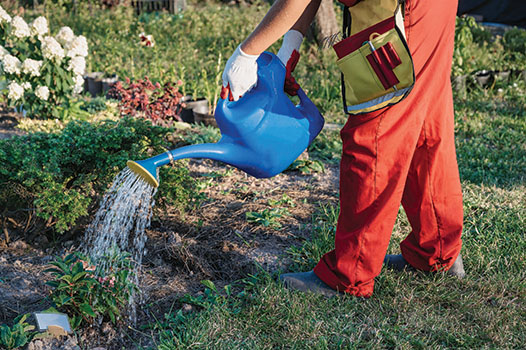As we enter the hottest months of the year, your plants and flowers will require special attention. Here are some tasks to address this month to ensure they remain healthy and thriving this summer and beyond:
- Since July is usually our wettest month, turn off or reduce watering frequency of your irrigation system when not needed. A rain gauge will determine whether we’ve had sufficient rain for lawns and landscapes.
- A light application of fertilizer may be needed to keep annual beds looking their best.
- July weather is favorable to pests. If caught early enough, some infestations can be kept under control by hand- picking the pest or disposing of infected leaves. Pesticides or fungicides may be necessary, especially on lawns. Proper identification is imperative to treat effectively.
- Azaleas and camellias are under stress as they are setting next year’s buds. Water them through any dry spells. Agapanthus, also called lily of the Nile, is very popular along the Gulf Coast. If they dry out during the heat of summer, they won’t bloom next spring.
- Cut back perennials and fertilize with a slow-release fertilizer to encourage more flowers. Slow-release fertilizers are safter for the environment and last longer.
- Potted plants dry out much faster in the summer heat. They may require watering daily; some twice a day. A humectant mixed in the soil when planting may help retain moisture so watering is decreased.
- Cover dark pots do avoid extreme heat to the roots. Dark pots may be placed inside lighter ones to help with this.
This is also an apt time to consider healthy environmental habits when it comes to gardening. I recently returned from London, where I was excited to attend the Chelsea Flower Show. The show has been held since 1912 and only was halted for World Wars I and II. It was started to raise money for the Chelsea Hospital, which was established to treat veterans of all branches of the British military.
Chelsea Flower Show exhibitors must submit proposals months in advance that are juried. Growers, designers, seed companies and small garden equipment are presented in beautiful settings, many under huge tents. Display gardens are erected in a week of intensive activity and judged based on criteria established by the Royal Horticulture Society. Competition is fierce.
Environmental impacts of products and services are of great importance. Most floral designs used wire, native vines and limbs to support their designs. Compostables and sustainable practices were front and center. As 97 percent of the United Kingdom’s pollinators have been eradicated, largely due to the use of pesticides, there is a huge push to reverse this trend.
Wildflowers and native grasses once again are allowed to grow on roadsides. Hedgerows are encouraged, giving small animals like hedgehogs and rabbits more habitat and safe passages. Homeowners are being enlisted to plant native plants in their gardens. One can only hope America follows suite with these positive practices.



